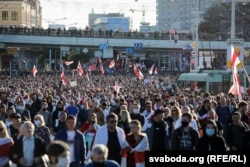As soon as Belarusian protesters wrap up their daily demonstrations on the streets, the movement goes online to assess tactics and to begin planning the next course of action.
"Observations from yesterday," a Telegram user going by the name Byternity wrote on September 21, following the latest weekend of postelection rallies and mass arrests. "At the opera house, a small number of people separated from the column, someone to rest, some were just going to leave, and at that time a lot of buses drove right behind the column. After that, the hunt for stragglers with symbols began."
The tip was from one of scores of digital "courtyard chats" that demonstrators are accessing on the encrypted Telegram messaging app to spread the word in cities, factories, and specific localities across Belarus.
And the chats are just one modern resource being tapped by protesters to show a united front against President Alyaksandr Lukashenka, whom they believe stole the August 9 presidential election.
The risks are high, with opposition leaders such as Maryya Kalesnikava jailed after being accused of using media and the Internet to stage protests. But Belarusians are defying the authorities by going online to expose members of the security services cracking down on demonstrations, recruit volunteers, share news and information, and strategize methods of peaceful protest.
After several thousand women marching in Minsk on September 19 were met with violence and detentions by riot police, hackers responded by releasing the names and personal data of 1,000 police officers.
WATCH: Belarusian police detained hundreds of protesters in Minsk as several thousand women marched through the capital.
"As the arrests continue, we will continue to publish data on a massive scale," the hackers said in a statement on various Telegram channels including Nexta Live, a news outlet that has successfully used the service to circumvent Belarus's strictly controlled media environment.
The Interior Ministry countered by threatening that "the forces, means, and technologies at the disposal of the Interior Ministry bodies make it possible to identify and prosecute the overwhelming majority of those guilty of leaking personal data on the Internet."
But on September 21, following hundreds more detentions, the channel Black Book of Belarus was stocked with fresh images, home addresses, and telephone numbers of police and judges alleged to be complicit in the repression of protesters.
"Friends, today the punishers crossed the line again," read a message on the site at day's end. "They kidnapped people on the streets (even a pregnant girl), fired guns, sprayed tear gas."
The site, which describes itself as a base in Minsk and the surrounding region for "endangered species: riot police, traffic police, Interior Ministry troops and other security forces," provides links for readers in cities such as Minsk, Brest, Hrodna, Homel, Vitsebsk, and others to send information about alleged abusers.
"It is in the district and regional cities where we can return the rule of law in the near future," the post declared.
Online, In Plain Sight
Administrators of online forums are well-aware that demonstrators are not the only ones reading.
The header of Minsk Courtyard Chats, a shared Google document that provides links for chats catering to specific locales, warns contributors to count on Interior Ministry employees being present in any online discussion of more than 50 people.
"The main thing," it warns, is to "not violate the Criminal Code" and for users to stick to discussions of key issues "with activists you know personally and trust."
Fair game for discussion includes meeting places, efforts to honor slain protesters, what to wear during demonstrations, the situation of detainees, and alternative ways to show opposition to the authorities, such as refusing to pay local taxes.
In the case of Byternity, writing on the "Minsk: What kind of people, what kind of own" chat group, the advice for protesters to avoid being rounded up following a protest was to "hide everything" that might identify them as a demonstrator.
Another user suggests that demonstrators stick together. "A crowd of thousands of people with arms linked is a frightening thing," wrote the user, identified only as MG. "Yes, they will take someone, but it is much safer to stay in dense rows."
The Telegram channel Belarus of the Brain discusses the presence of provocateurs and how demonstrators might protect themselves in keeping with an overall opposition "Victory Plan."
According to one post on the opposition channel, Telegram users should remove telephone numbers and personal images, ideally new accounts should be set up using foreign SIM cards, and demonstrators should work with their housing administrators to secure their apartment buildings from members of the security services.
"It is necessary to make sure that no one except the residents of the entrance and their friends can gain entrance," the plan reads. "If the security forces still gain access, try replacing the intercom or code without giving it out to anyone other than the residents themselves."
If the housing administrators are unwilling to work with residents on this or other tactics such as installing surveillance cameras at entrances or even blocking them with junked cars, "this is another reason not to pay utility bills," the post adds.
There is safety in numbers, the channel says in advising demonstrators to stick to groups of at least 10 to 20 people, and to not carry out missions like removing the Belarusian flag from courtyards alone.
After all, it adds, when confronting Lukashenka "it is one for all and all for one!"
















